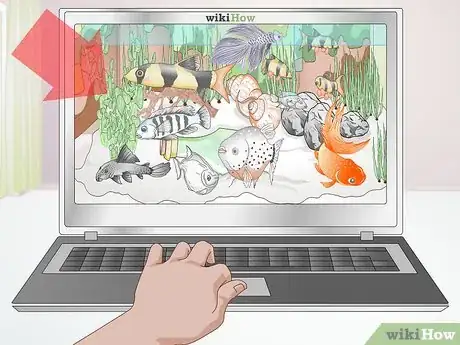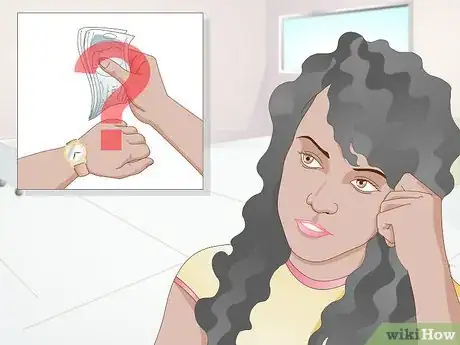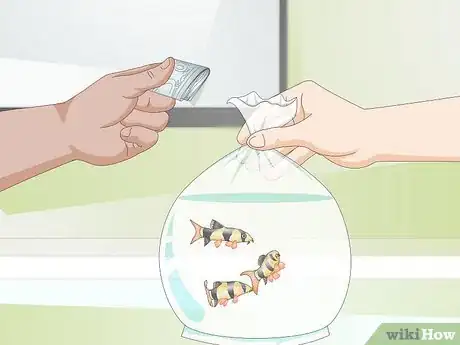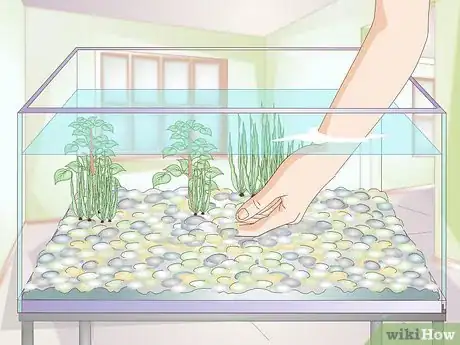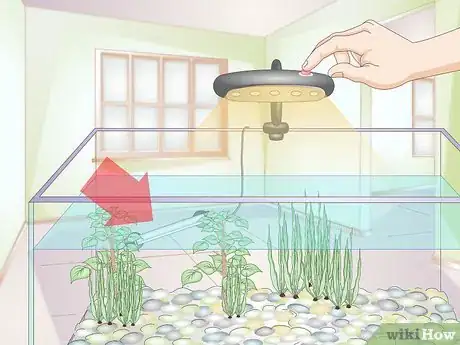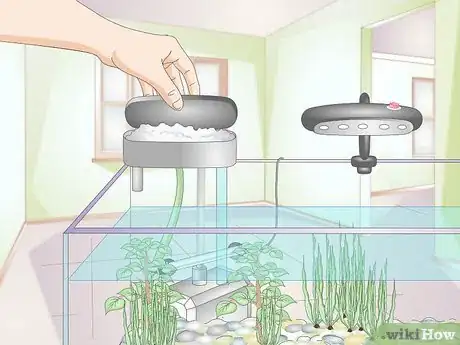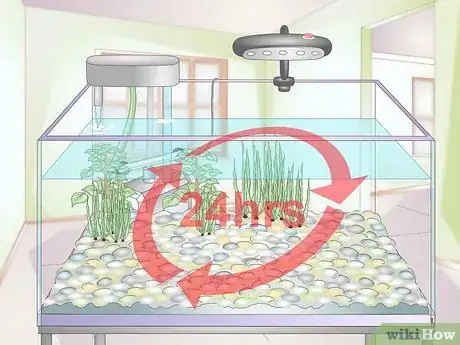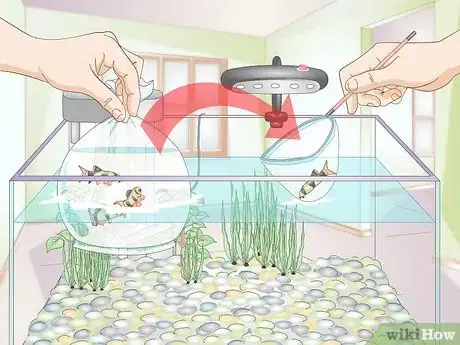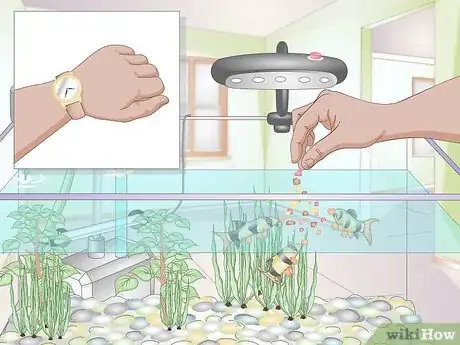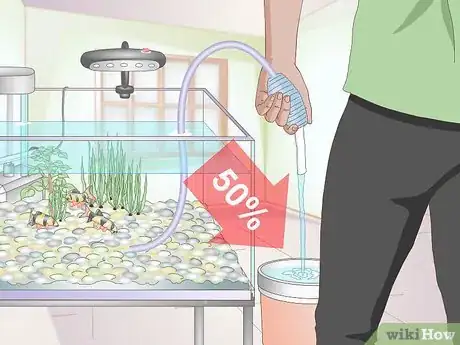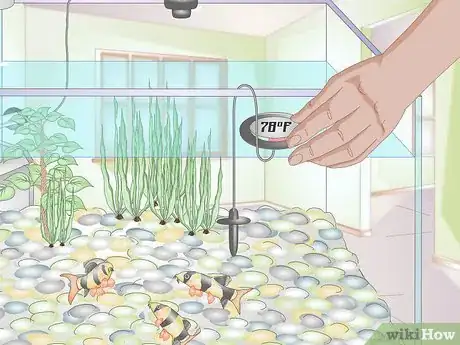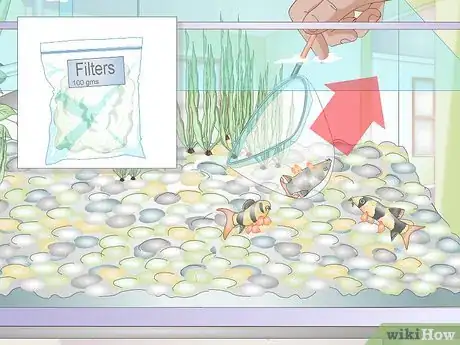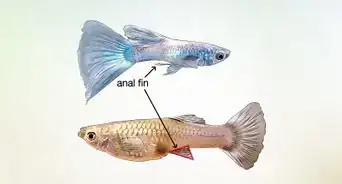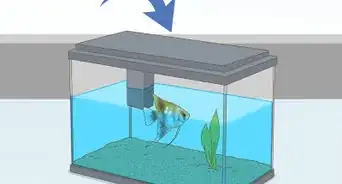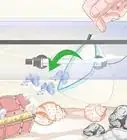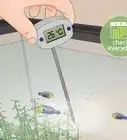This article was co-authored by Craig Morton. Craig Morton is the CEO of Aquarium Doctor Inc. based in Huntington Beach California and servicing Orange County, Los Angeles County, and the Inland Empire. With over 30 years of aquarium experience, Craig specializes in creating custom aquarium designs along with aquarium installation, service, and maintenance.
There are 13 references cited in this article, which can be found at the bottom of the page.
This article has been viewed 27,581 times.
If you are thinking of setting up an aquarium, stocking it with freshwater fish may be a great option for you. There are a wide variety of fish types that you can choose from, each with their own unique characteristics. However, all freshwater fish require a certain standard of care. Setting up the proper environment will keep your fish happy and healthy. Feeding and cleaning on a schedule will ensure that your fish live a long life.
Steps
Selecting the Right Fish
-
1Research different fish species. Look on the internet or at the library for information about your fish options. Take notes about the ones that seem particularly interesting to you. Do you like the bright color of goldfish or perhaps the unique shape of puffers? You can also ask the store clerk for assistance, but it is always best to go in with some prior knowledge.
- Joining a fish forum online is another good option. You can ask the members any questions and read through past posts. For example, they may be able to tell you that not all goldfish are the same. The rep cap oranda goldfish is a great starter fish, but requires a tank of at least 30 gallons.[1]
-
2Consider your experience level. Freshwater fish are generally considered to be more ‘beginner friendly’ than their saltwater counterparts. However, there are still different levels of care. Ask yourself, how much time do I have to care for a fish? How much money do I have to spend on equipment? If you are limited in resources and time, a low-maintenance fish may be good for you.
- A fahaka puffer is an example of an expert-level fish. They are difficult to keep alive in captivity and require very large tanks well-stocked with plant life. In contrast, a standard betta is a carnivore that can live in a smaller tank, with a pretty straightforward diet of dried food.[2]
Advertisement -
3Take notice of compatibility. “Species tanks” or tanks with just one fish are nice, but if you want to add in other types, you will want to do some thinking beforehand. Consider the temperaments of the fish as well as their life requirements. Do not pair peaceful fish with aggressive ones. Make sure that all fish in your tank need roughly the same temperature and pH levels.
-
4Watch overcrowding. Match your tank dimensions to the final size of your full grown fish. Calculate the surface area of your tank by multiplying the length times the width (in inches) and dividing by 12. This will tell you the number of fish of that your tank can sustain.
- Coldwater fish require more room than their tropical counterparts. For coldwater, follow the same formula but divide by 30 instead of 12.[3]
- Overcrowding is a serious issue as it can contribute to toxic ammonia levels, overtaxed filtration systems, injured or sick fish, and an overall dirty tank.
-
5Make the purchase. You can buy fish online, direct from a breeder, at a pet store, or at an aquarium store. Choose a company that has positive reviews and is well-established. Look for clean tanks with numerous fish options. Select fish that appear healthy and vibrant, swimming and inspecting their environment. Stick to your plans and don’t overbuy to avoid overcrowding.[4]
- Handle the fish bag carefully on the way home. Don’t jostle or shake it or you will agitate the fish.
Putting it All Together
-
1Choose a tank location. Place your tank in an area without consistent direct sunlight, to prevent the growth of algae. You need a flat, level surface with access to a reliable electrical outlet. The area will also need to support the weight of the tank. You can estimate 10-12 pounds per gallon with gravel added.
- Keep the tank away from your home’s AC or heater unit as it will cause the temperature to fluctuate dangerously.
-
2Add gravel. Most people like to include gravel as it increases visual appeal and helps to trap debris at the ground level. Estimate 1.5-2 pounds of gravel for every gallon of water in your tank. Rinse your gravel well before placing it in the bottom of your tank. Try to make it fairly level, although you can create a rise in the front of the tank, if desired.[5]
- Be aware that not all fish do well with gravel. It can be dangerous to some as they will mistake it for food and try to eat it.
- You can also add in plants (live or plastic) and other décor. Just note that everything that you put in the tank needs to be rinsed beforehand and will require regular cleaning afterwards. If you are looking to invest minimal time, limit your add-ons.
-
3Install your heater and light. A heater is used to keep your aquarium temperature at a certain level. An aquarium light allows you to see clearly into the tank and is a requirement if you have live plants. There are many different heater options including those that hang off the side of the tank, submerge in the water, or generate heat under the tank gravel via a coil.
- An aquarium hood with a light and heater combo is often a good idea as it protects your fish from airborne particles and keeps them in the tank. Whatever lighting setup you choose, just remember to limit its operation to 7-10 hours a day to prevent the growth of algae. Most lights come with timers.[6]
- Not all fish require the use of heater. Some cold water species, such as goldfish, are fine without one. Tropical fish, on the other hand, generally require a temperature between 75 and 80 degrees.[7]
- Aquarium plants often do the best with a coil heater as it keeps the gravel (i.e. soil) at a steady, warm temperature. Healthy plant life also means healthy, happy fish.
-
4Choose your filtration system. A filter is a tank necessity as it removes debris from the water, keeping it safe for your fish. You have three options: biological, mechanical, chemical, or a combination. Some filters even include built-in heaters to process and release cleaned, heated water back into the tank.
- Biological filters use biomatter (microorganisms, etc.) to digest and remove contaminants. There are canister filters with biomatter contained inside. Or, even natural sponges that float in the water with biomatter growing on them.
- Mechanical filtration involves water flowing through a device that captures debris and holds it.
- Chemical filtration uses activated carbon to extract toxins from the water. The carbon is usually contained in a canister container, often being both a mechanical and chemical filter in one.
-
5“Cycle” your tank. Use room temperature water and fill up the tank. Don’t pour the water in directly. Instead, use your hand or a plate to deflect it to the side of the tank then down, keeping your gravel intact. Add a few drops of water conditioner, or specifically a dechlorinator, to neutralize chemicals found in tap water that are dangerous to fish.[8]
- It generally takes 4-6 weeks for a tank to cycle.[9]
-
6Add the fish. Float the plastic bag containing the fish (or other container) in the tank for 15-30 minutes.[10] Then, at 5-10 minute intervals, put a little tank water into the bag. After this process is done, net the fish one-by-one and place them in the aquarium.[11]
- You should not add the bag water into the aquarium. You can dispose of it.
- The goal is to create a controlled, relaxed transport in order to minimise trauma and stress to your fish.
Maintaining the Health of Your Fish
-
1Feed on a schedule. Overfeeding is a common mistake as fish will always try to gorge themselves on food. Aim to feed your fish twice daily, so pick two times that work for you and stick to them. Only feed your fish what they can consume in a minute or two. Use a net to remove all extra food from the water’s surface.[12]
- Control the amount given by dropping in “pinches” of food at a time. Go slowly.
- Fish food is sold in pellet form, flake form, or freeze dried. Feeding a fish other live fish can lead to disease transmission. You can also purchase bloodworms or brine shrimp to supplement your fish’s diet.[13]
- If you are out of town you can set up a feeding block or automatic feeder.
- Some people also choose to use a feed/fast schedule. They do not feed their fish for one day out of the week. This is not harmful and can lead to a cleaner tank.[14]
- Overfeeding your fish can cause the water in their tank to be cloudy.[15]
-
2Clean the tank at least every other week.[16] Use your gravel siphon to remove between 25-50% of the water (depending on your tank and fish species) out of the tank and into a clean bucket. As you siphon, try to remove as much debris around the gravel as you can. Remove and scrub any plants or decorations. Remove algae from the glass using your siphon and an algae pad. Fill another bucket with tap water, add water conditioner, and let it sit for a few minutes. Refill the tank with the treated water.[17]
- You will want to unplug your filter and remove and rinse your filter pads. Use the water removed from the tank for rinsing as direct tap water will kill all the good bacteria.
- Make sure to unplug your heater or keep it lowered into the tank water during this process.[18]
- Wipe down the outside of the tank with a paper towel or cotton rag after you are finished.
-
3Monitor the temperature. Get a stick-on thermometer and place it on the outside of the tank. Monitor the temperature on a daily basis, just by taking a quick glance. You should generally keep the tank between 76 to 80 degrees. If the temperature is off, you may need to think about changing your heater or the location of the tank.[19]
-
4Invest in a water testing kit. You can purchase a simple kit at most pet and aquarium stores. It will contain testing supplies for ammonia, nitrate, nitrite, alkalinity, and water hardness. It will also contain information about the safe limits of these various elements. A kit will take of the guesswork away from maintaining your water.[20]
- Ammonia is particularly toxic and dangerous as it originates from the feces of fish. It can cause stress and death. Another reason to monitor and maintain a functioning filtration system.[21]
-
5Address any problems immediately. Go to the few pet store to stock up on extra supplies (filters, etc.) just in case. If you notice cloudy water, for example, you want to test the water right away. Keep an eye out for other visual signs of trouble, such as dead fish or frayed fish. You may need to isolate sick fish and dead fish need to be removed.[22]
Community Q&A
-
QuestionWhat items can I decorate my tank with?
 Craig MortonCraig Morton is the CEO of Aquarium Doctor Inc. based in Huntington Beach California and servicing Orange County, Los Angeles County, and the Inland Empire. With over 30 years of aquarium experience, Craig specializes in creating custom aquarium designs along with aquarium installation, service, and maintenance.
Craig MortonCraig Morton is the CEO of Aquarium Doctor Inc. based in Huntington Beach California and servicing Orange County, Los Angeles County, and the Inland Empire. With over 30 years of aquarium experience, Craig specializes in creating custom aquarium designs along with aquarium installation, service, and maintenance.
Aquarium Specialist, Aquarium Doctor Inc. We generally don't recommend anything other than decorative products that are labeled as "aquarium-safe."
We generally don't recommend anything other than decorative products that are labeled as "aquarium-safe." -
QuestionHow do I treat white spots on fish?
 Community AnswerThe white spots are a disease. There are medicines you can put in the tank, but there's not much else you can do about it. After the infection is gone, either clean or replace the tank.
Community AnswerThe white spots are a disease. There are medicines you can put in the tank, but there's not much else you can do about it. After the infection is gone, either clean or replace the tank. -
QuestionWhat is that white lump growing on the mouth of my bala shark?
 Community AnswerThe lump is a tumor or mouth fungus, to treat it use malachite green or methyne blue.
Community AnswerThe lump is a tumor or mouth fungus, to treat it use malachite green or methyne blue.
Warnings
- Be very careful when moving an aquarium. Never move it when full or partially full. Always dry your hands beforehand and don’t lift it by the frame.⧼thumbs_response⧽
Things You’ll Need
- Freshwater fish
- Aquarium
- Filter
- Lighting
- Heater
- Gravel
- Decorations
- Water Conditioner
- Net
- Gravel siphon
- Fish food
- Algae pad
- Clean bucket
- Water test kit
- Paper towels or cotton cloth
References
- ↑ http://www.earthsfriends.com/freshwater-aquarium-fish/
- ↑ http://www.earthsfriends.com/freshwater-aquarium-fish/
- ↑ http://animal-world.com/encyclo/fresh/information/freshwater.htm#setup
- ↑ http://www.petmd.com/fish/care/evr_fi_how-to-care-of-fish#
- ↑ http://www.marineland.com/Guides/starting-an-aquarium-beginners.aspx
- ↑ http://www.marineland.com/Guides/starting-an-aquarium-beginners.aspx
- ↑ http://www.marineland.com/Guides/starting-an-aquarium-beginners.aspx
- ↑ http://www.firsttankguide.net/dechlorinator.php
- ↑ Craig Morton. Fish & Aquarium Specialist. Expert Interview. 21 July 2020.
- ↑ Craig Morton. Fish & Aquarium Specialist. Expert Interview. 21 July 2020.
- ↑ http://www.marineland.com/Guides/starting-an-aquarium-beginners.aspx
- ↑ http://www.petmd.com/fish/care/evr_fi_how-to-care-of-fish#
- ↑ http://www.petmd.com/fish/care/evr_fi_how-to-care-of-fish#
- ↑ https://pethelpful.com/fish-aquariums/How-to-Care-for-a-Fish-Tank-Aquarium-Maintenance-Tips
- ↑ Craig Morton. Fish & Aquarium Specialist. Expert Interview. 21 July 2020.
- ↑ Craig Morton. Fish & Aquarium Specialist. Expert Interview. 21 July 2020.
- ↑ http://animal-world.com/encyclo/fresh/information/fish-care.php
- ↑ http://www.marineland.com/Guides/starting-an-aquarium-beginners.aspx
- ↑ http://www.tfhmagazine.com/aquarium-basics/temperature-control.htm
- ↑ http://www.earthsfriends.com/freshwater-aquarium-fish/
- ↑ http://www.firsttankguide.net/filters.php
- ↑ http://animal-world.com/encyclo/fresh/information/fish-care.php
- ↑ https://www.parenting.com/story/5-tips-for-caring-for-pet-fish/
About This Article
To take care of your freshwater fish, place your tank in an area out of direct sunlight, which will prevent algae from growing in it. Once you find a spot for your tank, you’ll need to install a heater, light, and filtration system to keep your fish healthy. After you purchase your fish, make sure to feed them twice a day at the same time each day to prevent them from overeating. You should also clean the tank every other week to clear prevent bacteria from making your fish sick. To do this, use a gravel siphon to remove roughly 1/4 of the tank water. Then remove and scrub any plastic plants or decorations. To learn how to use a water testing kit to keep your fish’s tank clean, read more from our Veterinary co-author.
